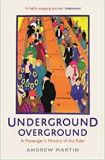Underground Overground: A Passenger's History of the Tube by Andrew Martin
| Underground Overground: A Passenger's History of the Tube by Andrew Martin | |
|
| |
| Category: History | |
| Reviewer: John Van der Kiste | |
| Summary: A very readable yet thoroughly researched history of the London Underground, the oldest, most characterful and downright illogical metropolitan transport system in the world, which carries over one billion passengers every year. | |
| Buy? Yes | Borrow? Yes |
| Pages: 304 | Date: April 2012 |
| Publisher: Profile | |
| ISBN: 9781846684777 | |
|
| |
Although he was born in Yorkshire, Andrew Martin has long been enthralled by the London Underground. His father worked on British Rail, and Andrew himself therefore had free travel on the system as well as a Privilege Pass which entitled him to free first-class train travel on the national rail network. Having lived in London for twenty-five years, commuting to various newspaper offices in his employment as a journalist, a job which has included writing a regular magazine column, Tube Talk, he is well qualified to write this entertaining and enlightening social history of the world's most famous underground railway.
This was surely not a straightforward book to complete. Universally recognized as the oldest and most downright illogical metropolitan transport system in the world, 'the tube' has developed in a curiously haphazard version ever since the Metropolitan Line opened in January 1863, running from Paddington (then Paddington Bishop's Road Station) to Farringdon. Ever since then, it has been a sprawling network of improvisations and botch-jobs – but, in that peculiarly British compromise of muddling through, it works very well in practice. If it did not, it would hardly be carrying over one billion passengers a year.
That the Victorians ever had such a means of transport was down to a handful of forward-thinking souls. One was Charles Pearson, a solicitor working for the London Corporation, a man of radical views who campaigned tirelessly for good causes. Another was the future Prime Minister William Gladstone, who was greatly in favour of public transport for several reasons and said that the best way to see the metropolis was from the top of a bus. While underground trains may not allow their passengers comparable views of the world around them, it is worth noting that the early carriages were essentially ordinary steam trains which ran below the streets in the middle of the City. As they were on normal tracks, after emerging from their tunnels they reappeared in the open air, and once more became part of the main-line railways. Even today, the 'underground' is 55% overground.
Within a year of the Metropolitan Line opening, the system had expanded eastwards to Moorgate, a station which in 1975 would be tragically associated with the worst peacetime disaster on the system. After a few months it was joined by the Hammersmith & City Railway – in the days when, as the author reminds us, Hammersmith was still a pretty village. It proved an immediate success, and The Times was soon forced to eat its words of November 1861 that the proposed railway was Utopian, adding that even if it could be accomplished it would surely never pay. When it opened, the Metropolitan was hailed by the same paper as the greatest engineering triumph of its day, and its ingenious contrivances for obtaining light and ventilation were particularly commended. By 1875 the Metropolitan and the District lines were carrying about 100,000,000 passengers on their branches and unclosed circle, as further stations were added to the network. The doubters who maintained that it could never work were proved very wrong.
Throughout his text, as he traces the development of an enterprising Victorian scheme which like Topsy just growed, Martin produces several rather appealing facts and tidbits. Overcrowding was declared to be a permanent feature of the rush hour operation of trains – not since the introduction of the Travelcard in 1983, but as long ago as 1915. Nothing changes. The Circle Line was known as the comedy turn of the Underground, and generated various urban myths such as the man who died on it and then went round all day, or the language school which conducted its classes on Circle trains, as the collective daily fare was cheaper than office rental. The author was personally informed by an engineer that it would be better if we did not walk on the escalators, but merely stood patiently on them, as the swaying and bouncing motion is bad for them. Moreover, it is perhaps not surprising to read that when the Lost Property offices opened, the most frequently mislaid items were umbrellas, with quarter of a million a year being collected or handed in. These days, it is nearer 10,000, indicating that the age when every white-collar professional carried one is long since gone – or maybe people are more careful these days. The unsurprising fact that cellphones were high on the list of lost items on the trains in 2011 seems to disprove the latter theory. Victoria is the busiest station, with Oxford Circus and King's Cross not far behind.
This is a very informative history of the sprawling system which has long been part of every resident's or visitor's experience. Martin writes with commendable humour, while not brushing aside tragic aspects such as the Moorgate disaster referred to above, and likewise the even more shocking wartime tragedy in March 1943 at Bethnal Green when 173 people were killed, largely as a result of panic when people crowded into the station for shelter at the sound of anti-aircraft guns. Like it or loathe it, it is surely impossible to imagine London without the Underground, and anybody who was ever travelled on a train through those often dark and overcrowded tunnels will surely approach this book with fascination as I did, unable to resist the opportunity to learn more about how the mighty oak grew from a small acorn in mid-Victorian Britain.
If this book appeals then we think that you might also enjoy London Under by Peter Ackroyd or Rush Hour by Iain Gately.
Please share on: ![]() Facebook,
Facebook, ![]() Twitter and
Twitter and
![]() Instagram
Instagram
![]() You can read more book reviews or buy Underground Overground: A Passenger's History of the Tube by Andrew Martin at Amazon.co.uk Amazon currently charges £2.99 for standard delivery for orders under £20, over which delivery is free.
You can read more book reviews or buy Underground Overground: A Passenger's History of the Tube by Andrew Martin at Amazon.co.uk Amazon currently charges £2.99 for standard delivery for orders under £20, over which delivery is free.
![]() You can read more book reviews or buy Underground Overground: A Passenger's History of the Tube by Andrew Martin at Amazon.com.
You can read more book reviews or buy Underground Overground: A Passenger's History of the Tube by Andrew Martin at Amazon.com.
Comments
Like to comment on this review?
Just send us an email and we'll put the best up on the site.


